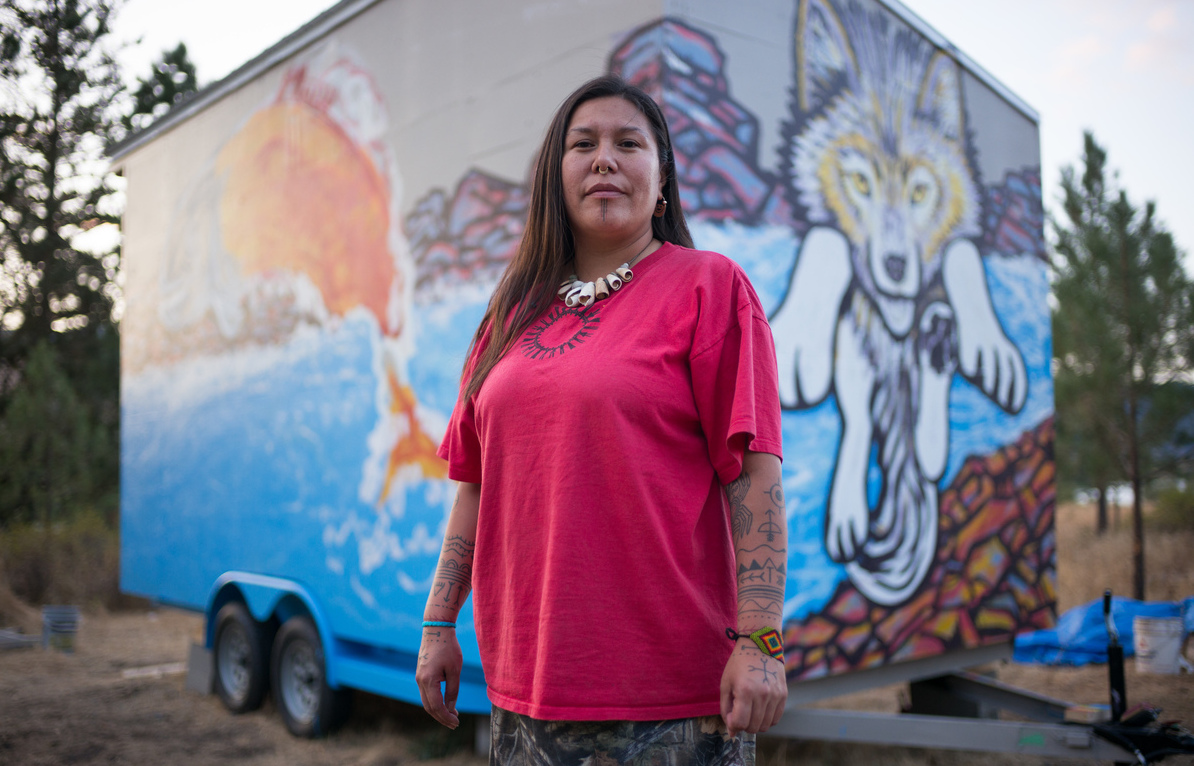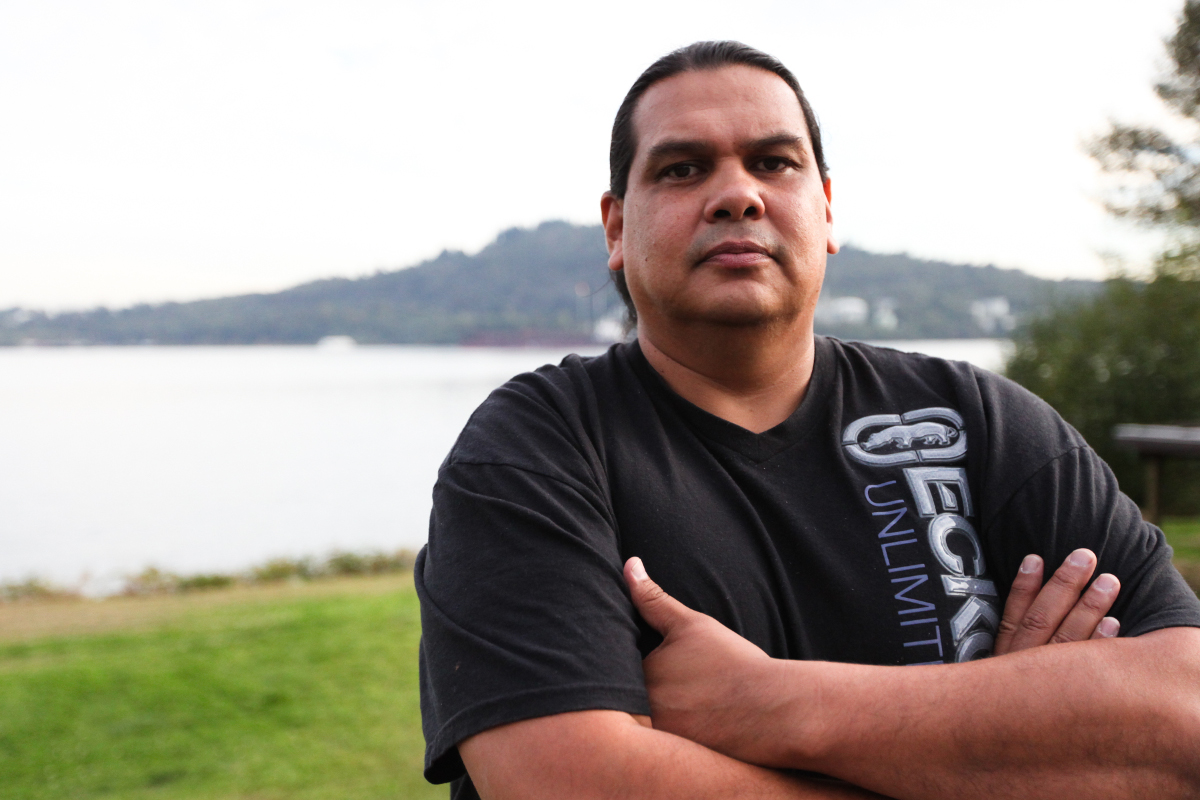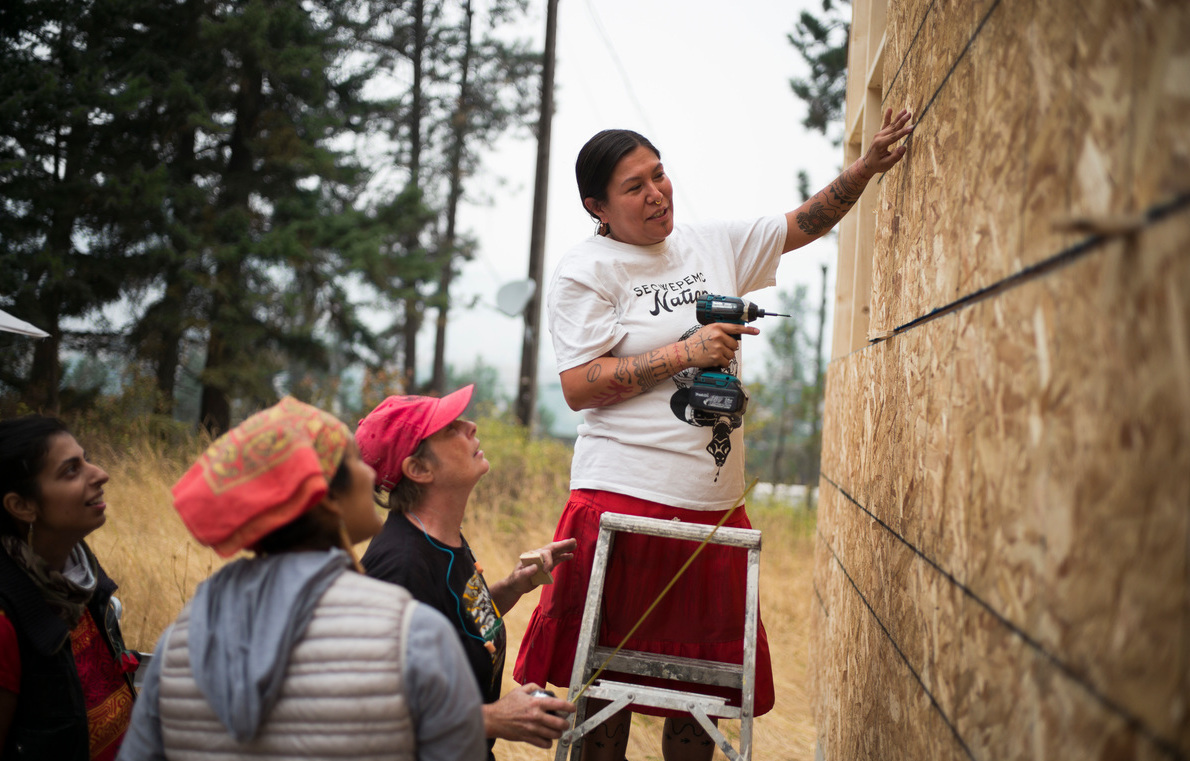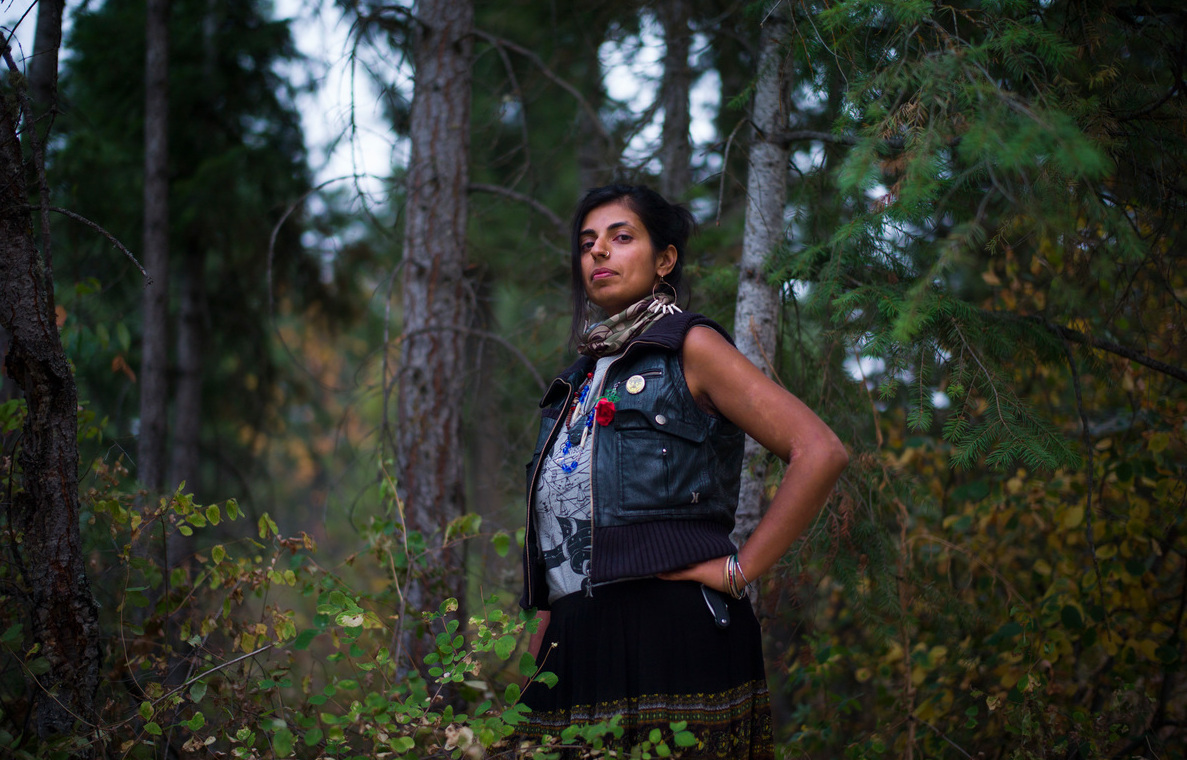
The Indigenous activists battling Kinder Morgan’s pipeline expansion
There’s a high-pressure pipeline standoff brewing in British Columbia, that could resemble Standing Rock, where state and corporate-sponsored violence was levied against unarmed water defenders in North Dakota in 2016 . Though they’ve taken lessons from the campaign to protect Standing Rock from the Dakota Access Pipeline, Indigenous leaders in British Columbia are waging this new fight on their own terms.
Kinder Morgan fails to act in good faith with Indigenous groups
The Trans Mountain expansion (TMX) is a $7.4 billion project to create a second, mostly parallel line to an existing pipeline first completed in 1953 to carry diluted bitumen from oil fields in Alberta to the Vancouver suburb of Burnaby. TMX received federal approval in November 2016 but has not been allowed to officially begin construction due to 157 conditions being levied by the National Energy Board of Canada (NEB).
Despite the 157 conditions Kinder Morgan has placed spawning deterrents in streams and erected a chain-link fences topped with razor wire around its marine terminus in Burrard Inlet. In mid-December 2017 the NEB affirmed that Texas-based Kinder Morgan Inc. could ignore municipal bylaws in Burnaby, B.C. to ease construction of the second pipeline, despite fierce opposition from the local community.
But most importantly, Kinder Morgan failed to consult with all of the nearly 140 Indigenous groups along the project’s proposed route.
The First Nations in opposition collectively pose the largest threat to TMX. Indigenous people who oppose this project are doing so from a variety of angles, including the application of the United Nations Declaration of the Rights of Indigenous Peoples (UNDRIP), economic, ecological, science-based assessments, and filing collective legal challenges. One key strategy is demonstrating that traditional nationhood-based protocols remain the highest level of governance on lands where treaties were never signed between First Nations and the federal or provincial government.
Kinder Morgan bought the Trans Mountain pipeline in 2005 and since 2013 has known about 130 separate Indigenous groups requiring full consultation before any construction can begin. Most of these Indigenous groups, however, are approached through the federal regulated Band Office system, which is not where decision-making power resides.
“All our research showed it is not a matter of if, but when there will be a spill. This might not happen on our territory, but we are not just in this for ourselves. We are here to protect our family and that includes all people, the water, and the animals who stand to be harmed when this project causes destruction.”
Band Offices hold sway over delineated reserves, which are federally-determined areas where Status Indians generally live, as opposed to traditional territory which are vast tracts of land comprising the entire area from which Indigenous groups have historically sustained themselves. In B.C., where no treaties exist, Indigenous people collectively hold decision-making power, a fact recognized by the 1997 Delgamuukw decision by the Supreme Court of Canada.
Thus far, Kinder Morgan has signed signed agreements with more than 50 Band Offices along the pipeline route.
Ian Anderson, president of Kinder Morgan Canada, has threatened to sue based on ‘unnecessary’ bureaucracy surrounding the pipeline’s approval process, but various Indigenous groups are demonstrating that in B.C. those permits are not the final word on industrial projects.
The majority of B.C. is unsurrendered, unceded Indigenous territory, which means Indigenous Nations are still the rightful titleholders, as several Supreme Court of Canada decisions have found, including the 2014 Tsilhqot’in decision, which followed on the heels of Delgamuukw.

The Tsleil-Waututh legal battle against a new pipeline
Despite decisions like Delgamuukw and Tsilhqot’in, neither Kinder Morgan nor Canada can be said to operate in good faith or the highest standard of consultation where this pipeline is concerned, according to Reuben George, project manager of Tsleil-Waututh Sacred Trust (TWST), which is one of the Indigenous-based organizations leading the stand against a project that is not in anyone but Kinder Morgan’s best interests, he says.
The TWST has compiled data specific to how the TMX project will impact the collective territory it holds with the Squamish and Musqueam Nations. That data clearly points to the inevitability of an oil spill.
George also led a charge to Kinder Morgan’s head office in Houston, Texas to deliver a petition with nearly 60,000 signatures showing opposition to the TMX.
“All our research showed it is not a matter of if, but when there will be a spill,” George says. “This might not happen on our territory, but we are not just in this for ourselves. We are here to protect our family and that includes all people, the water, and the animals who stand to be harmed when this project causes destruction. All of our research is science-based and done by experts in each separate field,” he added.
George has been part of the TWST opposition to Kinder Morgan’s expansion request from its inception. He and other members of the organization delivered a TMX project assessment to the government of Canada in November 2016, but the extensive document wasn’t given much consideration, says George.
Less than an hour after the documents were delivered, the federal government announced its approval. George claims this does not meet the requirement of good faith consultation.
“It was almost 2,400 pages of research about why Kinder Morgan should never expand based on Tsleil-Waututh law,” George notes. “And we had found out later that the federal government had created a webpage rationalizing the need for this project. This website was launched three weeks before the approval was given.”
The main TWST arguments in a judicial review set to be decided in February/March 2018 are based on the lack of consultation by federal and provincial governments and the impact the expansion will have on the marine ecosystem– specifically southern resident killer whales and salmon, says George.
Currently five tankers depart from Burrard inlet per month and the upon completion of TMX, traffic would necessitate 34 departures. Orcas, a species on the brink of extinction, are running out of their main source of food, namely salmon–and this is a bridge too far, says George.
The despair felt by George and others is not without reason.
George has zero confidence in the NEB based on two appointees. Steven Kelly, a former Kinder Morgan consultant, helped create the TMX proposal, which the federal government then used to justify its approval of the project. Kim Baird is a Tsawwassen First Nations chief, who was appointed to a TMX advisory board.
“In my view, the NEB has been corrupt since day one,” George said. “Kelly wrote more than 20 percent of Kinder Morgan’s application to the NEB, so this has been a farce from the beginning.”
“You can’t unscramble an egg,” George adds, referring to Baird’s 2016 inclusion by Trudeau’s government on an NEB advisory panel.
The federal and provincial governments of Canada are currently solely required by law (Section 35 of the Canadian Constitution) to fully consult with Indigenous peoples according to Canadian statute and bolstered by Supreme Court decisions. This federal responsibility has thus far been deferred to Kinder Morgan.
“Our connection to our land goes down into our DNA. We feel the trauma our land goes through when it is destroyed. Society has no comprehension what these projects do to Indigenous peoples because of our link to the land.”
However, in Canadian law, nothing resembling the United Nations Declaration of the Rights of Indigenous Peoples (UNDRIP) has ever been ratified. The key component of Free, Prior and Informed Consent (FPIC) is the standard by which most Indigenous governments operate, which was established well before contact with European entities. Where no treaty exists FPIC is necessary, and this has precedent on the ground where the Unist’to’ten in northern B.C. are standing against a multitude of proposed pipelines across its territory. FPIC in British Columbia means, in most cases, that any plant, mineral, or animal removed from a given territory requires permission from the leader or house group beforehand. Failure to obtain FPIC pre-colonization was met with severe penalty — including death or lifelong banishment.
UNDRIP has been the subject of several debates and discussions nationally in Canada. The federal government announced in November 2017 a plan to alter existing Canadian law to match the international declaration, but Indigenous leaders are not willing to wait for the government to grant permission they know is not the government’s to give.

Nationally, the Indian Act, federal legislation governing Indigenous people in Canada, has enabled corporations to circumvent Indigenous right and title. Corporations do this by signing deals with Band Office administrations, but this is a new version of longstanding aversion to Indigenous sovereignty that aims to deliberately disavow any knowledge of Indigenous sovereignty.
The Canadian government was growing concerned its burgeoning, national sovereignty was in jeopardy in the 1920s and to combat this the Indian Act was amended to prevent Indigenous peoples from hiring a lawyer. This removed any chance that Indigenous groups could question colonial authority while industry was gaining a foothold.
So when the first pipeline from Alberta to the B.C. coastline was proposed in 1951 Indigenous people had no ability to make a legitimate legal challenge, even though the Indian Act had just been amended to allow Indigenous peoples the rights to potlatch, hire lawyers, enter a pool hall, and vote.
Since the 1920s, Indigenous peoples in Canada have increasingly made sure all levels of government are aware of right and title as fact, and this has been a core component of every land-based court case between Indigenous peoples and Canada historically.
The Secwe̓pemc: fighting with direct action and tiny homes
The battle against TMX is most prominent in the Manuel lineage of the Secwe̓pemc (Shuswap Nation) which is an Interior Salish group and part of the larger Salish people that extends from Vancouver Island to northern California.
Kanahus Manuel comes from a family steeped in both traditional indigenous knowledge and an understanding of international and western law. Manuel has a deep commitment to opposing corporate and government activity where it threatens water, land, or air. This passion led her to participate on the front lines of the Standing Rock Reservation dispute against the Dakota Access Pipeline. It’s a commitment to resistance that has deep family roots.
Her grandfather, George Manuel, was instrumental in creating the United Nations’ World Council of Indigenous Peoples in 1975, of which he was elected the inaugural president.
George Manuel also created the Constitutional Express, which played a large role in convincing the Canadian government to include Indigenous rights in its constitutional amendments of 1982.
Arthur Manuel, Kanahus’ father, was the one who helped her recognize the importance of keeping the Canadian leadership’s feet to the fire. Arthur Manuel is the author of two books: Unsettling Canada: A National Wake-Up Call, and more recently The Reconciliation Manifesto: Recovering the Land, Rebuilding the Economy, which both point directly to the difficulties Indigenous peoples have encountered due to sovereignty being denied them by Canadian government entities.
Based on what Kanahus Manuel has learned from her family and her experiences doing direct action against large-scale industrial projects, there is only one true authority on Secwe̓pemc territory, which covers 180,000 square kilometres and can be found between the cities of Hope and Williams Lake, British Columbia. The collective will of the people based on traditional Secwe̓pemc law hold sway over any Canadian or international interest.
Kanahus knows what is at stake and despite her knowledge of the law, she is committed to ensuring the 322 miles of the proposed TMX pipeline set to go through Secwe̓pemc territory are never built.
The cultural foundation she is rooted in is her guiding force.
“Our connection to our land goes down into our DNA,” Kanahus said, speaking directly to the destruction of the environment by industry. “We feel the trauma our land goes through when it is destroyed. Society has no comprehension what these projects do to Indigenous peoples because of our link to the land.
“I am a conduit, a vessel for this spiritual awakening that is happening,” she says, referring to Idle No More, a protest movement comprised of allied First Nations, Métis and Inuit people in Canada, as well as the Standing Rock Sioux. She sees these movements as evidence of a shift in Indigenous consciousness and action. “This is part of the larger picture that needs to be told,” she says.
One of the direct threats to the Secwe̓pemc people, namely its women, that Kanahus draws attention to are the ‘man camps’ that are always part of pipeline construction. These camps consist of portable housing for temporary workers and are directly connected to a rise in violence, drug trafficking, prostitution, and other crimes.
The disproportionate rise in violence against Indigenous peoples, as noted in the national Missing and Murdered Indigenous Women (MMIW) inquiry among other sources, will only be exacerbated if TMX is allowed to proceed, Kanahus says.

“To combat this we need a diversity of tactics,” she adds. One of those tactics is the building of tiny houses.
The Tiny House Warriors, which Kanahus is part of, plans to put 10 of its small dwellings in the path of where Kinder Morgan aims to build infrastructure necessary for pipeline construction. Once in place people will inhabit the Tiny Houses around the clock. This plan is part of a larger declaration by the Secwepemcul’ecw Assembly based on a TMX project assessment entitled Standing Rock of the North.
“[Kinder Morgan] has failed on multiple bases in crucial areas to account for the lack of political, legal, and proprietary certainty surrounding the pipeline,” the report states. “Core to its misleading projection is Kinder Morgan’s claim to have secured the land base for the pipeline …”
Delaying a project that hasn’t met the requirement of consultation and is being granted special privilege by national entities should be painting a clear picture to investors, Kanahus says.
“All work that Kinder Morgan does is expressly illegal. This is because neither the federal government nor the provincial government has any jurisdiction on unceded and unsurrendered territories. There is no legal document that allows these governments to exert any authority over these lands and waters.”
“Kinder Morgan does not have the money to build this pipeline. Every month they are losing $88 million dollars, as Ian Anderson quoted in his affidavit during the Burnaby Mountain trials,” she recalls. More than 60 people, both non-Indigenous and Indigenous, were arrested in 2014 during a brief standoff after a court injunction prohibited protesters from preventing exploration work near Simon Fraser University in Burnaby, B.C.
More recently, five people were arrested when protesting razor-wire topped fences surrounding Kinder Morgan’s terminus in Burnaby, an act of civil disobedience that Kanahus helped to organize.

Another part of the Secwe̓pemc land defense team is Anushka Azadi, who graduated law school at the University of Victoria. Azadi worked very closely with Secwe̓pemc elder Wolverine in the months before he passed away and credits him with informing her knowledge of the law and as her inspiration to carry on what started in motion — Indigenous sovereignty for the Secwepmc nation and stopping the TMX project.
“I learned more law from him in his final days than I gained from law school,” Azadi said. “That was a very special time for me and it tied my heart and my spirit to this area, to supporting the continuation of his legacy and working alongside his Nation and his family for what was stolen and what continues to be stolen daily.”
The ongoing theft Azadi speaks of is something several Indigenous and non-Indigenous scholars are working to uncover — Indigenous groups are the title holders of most land in Canada.
“All work that Kinder Morgan does is expressly illegal,” notes Azadi. “This is because neither the federal government nor the provincial government has any jurisdiction on unceded and unsurrendered territories. There is no legal document that allows these governments to exert any authority over these lands and waters. It is approved and given permits and then authority by governments that have no jurisdiction and authority.”
Not willing to merely speak out, Azadi and a handful of other activists went to streams on Secwe̓pemc territory and removed salmon spawning deterrents placed there by Kinder Morgan employees. These deterrents included rows of neon orange fencing normally used to mark out-of-bounds areas on ski hills. The fencing was placed in creek beds where the proposed pipeline is planned to cross waterways.
These deterrents were viewed as construction by the NEB, which means Kinder Morgan has broken some of their 157 requirements. Kinder Morgan was asked to remove the fencing, but was given no deadline to do so.
Following the spawning fence removal, Kanahus, Anushka and the Tsleil-Waututh were in Vancouver to remind Jim Carr, federal natural resources minister, Ian Anderson, Rachel Notley, Alberta’s premier, and others attending a Vancouver Board of Trade meeting about the TMX project, where true authority on the matter resides.
While Ian Anderson gave a speech insisting the TMX project should be allowed to start construction, Will George, a Tsleil-Waututh member, stood up and interrupted Anderson, insisting that Kinder Morgan does not have the consent of the Tsleil-Waututh to expand its existing project.
While the conference was taking place at the Waterfront Pacific Rim hotel a gathering of water and land defenders including Kanahus and Azadi were laying down the law as they have come to understand it.
Whatever the differences in their strategy, the Secwepmc, Tsleil-Waututh, and others who oppose this pipeline project on land where Indigenous people have lived for more than 15,000 years agree on one point:
They will do whatever it takes to stop Kinder Morgan.
Jerome Turner covers national and provincial issues with a focus on First Nations. Born and raised in Hazelton, British Columbia, he is of Gitxsan and Swedish descent. He is a graduate of Langara College’s journalism program, which included a focus on political science and Aboriginal studies.
Photo credits: images of tiny houses, Kanahus Manuel, and Anushka Azadi © Ian Willms / Greenpeace. Image of Reuben George © David P. Ball.
* This article was amended on 2/21/2018 to correct the spelling of the Tsleil-Waututh Nation and several other references to First Nations .
If you found this article informative, please consider making a donation today. Cascadia Magazine is a reader-supported publication, and we can’t publish quality writing on issues that matter to the people of the Pacific Northwest without your generous financial support.
